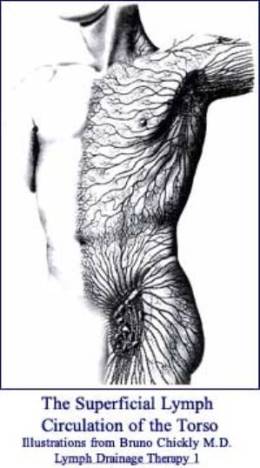Swollen Lymph Nodes (Adenopathy-Polyadenopathy)
We've all had them! Those swollen lymph nodes which are often mistakenly call "swollen glands" in common areas such as our neck or armpit. Since the lymphatic system is an important part of our immune system, swollen nodes often indicate your body's immune system is in combat mode.
Lymph Nodes are not only biological filters for toxins in our body but they are responsible for breaking down pathogens (foreign invaders). The lymph nodes do this by being "hotels" where your body's immune cells such as lymphocytes and white blood cells can hang out. When a pathogen is collected and transported to that hotel, a great deal of activity begins to happen within that hotel (your lymph node). Other parts of your immune system will also respond to make more immune cells. If a lymph node is enlarged, you can bet one of the following conditions is responsible.
Common Causes of Swollen Lymph Nodes
There are over 700+ lymph nodes in the adult human body and they are concentrated in clusters in the armpits, neck, groin, and abdomen. They can be shallow (just underneath the skin) or deep (surrounding and internal organ). They vary in shape and size from .5 to 2cm and can be round, oval, or pea shaped but can enlarge to several times greater than that. They may swell due to:
I. Infection is the most common cause or etiology. Infections come in many forms such as (1):
- Bacterial:
Such as a sinus infection, strep throat, staph infection, or salmonella (food poisoning). Lyme, pneumonia, staphylococcal, streptococcal, salmonella, syphilis, tetanus, gonorrhea, and bee stings, spider bites, tuberculosis are all examples of well known bacterial infections. Bacterial infections are often isolated to one area of the body and may cause the lymph nodes in the AREA effected to swell, thus helping you and your doctor identify where the infection is located. For example swollen lymph nodes in the neck area usually indicates an infection in the head, eye, mouth, nose, or throat.
- Viral: Such as colds, flus and post vaccination reactions. Cat scratch fever, West Nile Virus (WNV), mononucleosis, measles, infectious hepatitis, AIDS, are all examples of viral infections. COVID-19, SARS 1 and SARS 2 are also viral infections that can cause swelling of lymphatic nodes. Viral infections tend to be more systemic and therefore can cause lymph nodes in many parts of the body to swell.
- Parasitic or Protozoal:
Ring worm, liver flukes, malaria, giardia are all examples of parasitic infections that may lead to swollen lymph nodes. It is common to have them in the intestines as most parasites enter the body through food or water sources. These types of infections can be isolated or systemic (full body) and are often cyclical with more activity around the full moon.
- Fungal or Mold: Infections of this sort can often be made more complicated by allergies and may effect the skin.
II. Inflammation is the second most common cause or etiology for enlarged glands. Inflammation can be just an response to an allergen, food sensitivities or can be due to auto immune disease such as Lupus, Rheumatoid Arthritis, and so on....
III. Cancer or Neoplastic Diseases are the third most common cause for swollen nodes. Lymphoma, leukemia, breast cancer, prostate cancer, lung cancer, uterine cancer, and metastasis of any kind. If you are in remission from a cancer and have chronic swollen nodes, it is imperative you and your physician rule out cancer recurrence.
IV. Other causes may include extreme toxicity / poisoning or diseases caused by reactions to non-infectious agents such as serum sickness (reaction to foreign proteins in medication or vaccines), beryllium, heavy metal toxicity, heavy chemical toxicity.
 |
 Swollen glands aka: Swollen Lymph Nodes may be a sign of infection. |
Swollen Lymph Nodes and Cancer
Often inflammatory non-cancerous
nodes are PAINFUL, presenting signs of inflammation: swollen, hot and tender.. By contrast, cancerous nodes are usually firm
but not tender. There is ONE exception and that is Inflammatory Breast Cancer.
However, cancer can manifest in an inflammatory form in rare cases. Inflammatory breast cancer (IBC), for example, is an uncommon (3-6%) but usually fast-growing form of breast cancer. The inflamed breast can present with skin which is red, swollen and hot, sometimes accompanies by a peau d’orange dimple, itching or pain.
What if it is not a Lymph Node?
Things that may feel like swollen lymph nodes but are not (depending on the location in the body):
- Absess
- Cyst (fluid filled)
- Lipoma (fat filled benign tumor) or Tumor
- Scar tissue
- Mastitis (infected breast tissue or clogged duct)
- Hernia (in abdomen)
- Diverticula (in abdomen)
When to Seek Medical Care for Swollen Lymph Nodes
Inflamed nodes themselves are generally not a major concern, but if you have symptoms of another condition along with enlarged lymph nodes, consult your doctor. The diagnosis of swollen lymph nodes rarely requires emergency hospital treatment. The exceptions to this include a growing infection of the skin that requires treatment, a severely infected lymph node that needs to be drained, or severe pain.(2)
CALL YOUR DOCTOR:
- If the swelling of the nodes lasts for more than two weeks or you have symptoms such as weight loss, night sweats, fatigue, or prolonged fever
- If the nodes are hard, fixed to the skin, or are growing rapidly.
- If you can feel swelling close to your collarbone or in the lower part of the neck
- If the overlying skin is red and inflamed and you suspect an infection.
- If you are experiencing severe pain or difficulty breathing.
How Lymph Drainage Therapy Can Help Swollen Lymph Nodes and When to Seek Help
If you are unsure of the cause of your swollen lymph nodes and have no other symptoms, your lymph drainage therapist may be able to assist you by indicating where the lymphatic congestion is located in the body and if there is any rerouting or obstruction to the lymphatic flow. They may also be able to tell you which organs systems are most taxed or have poor circulation (spleen, liver, kidneys, large intestine). Additionally, a client's reaction to lymphatic work can indicate if they still have an active infection if more nodes swell or become large, then smaller after a session.
If you are out of the acute stage of infection (first 48 hours), Lymph Drainage Therapy can assist your lymphatics and eliminatory organs such as the Liver and Kidneys to expel the cause of your swollen nodes. We recommend a 30 minute session to start and please do not schedule an appointment if you have a fever. Depending on the clients current state of health, we may recommend more sessions or additional support from other providers to ensure your body has everything it needs to heal.
If you have a diagnosed condition and are under care of a physician, we recommend you seek the approval a recommendations for Lymph Drainage Therapy from your medical provider. For example, cancer patients need to stage the sessions at least 3 days away from chemo and those doing IV antibiotics for chronic Lyme will need have help clearing their bodies of impurities 2 to 3 days after a treatment.
RESOURCES:
(1) ”The Theory and Practice of Lymph Drainage Therapy". Pg. 48. Dr. Bruno Chikly.
(2) http://www.emedicinehealth.com.